We explore the Electric Blue Acara, a vibrant freshwater fish species. Originating from South America, this cichlid boasts striking blue hues, making it a popular choice for aquarium enthusiasts. We delve into its care requirements, including tank setup, water parameters, and compatible tankmates. Breeding tips and potential health issues are also discussed, providing a comprehensive guide for those interested in keeping this stunning aquatic creature.
While some fish have names that only indirectly represent them or names that might even be misguiding, this fish is everything the name indicates. They have a striking electric blue color that stands out no matter what other fish you keep in your tank, and it is one of the most stunning cichlids which is also surprisingly easy to keep. They require basic care that even a beginner can keep up with, and they are a beautiful addition to any freshwater tank
The electric blue acara, also known by its scientific name andinoacara pulcher hybrid, is a freshwater fish which relative – the blue acara, is native to Colombia, Venezuela, and other countries in South America. The electric blue acara is a man-made variation of the regular blue acara and it is a cichlid that belongs to the Cichlidae family.
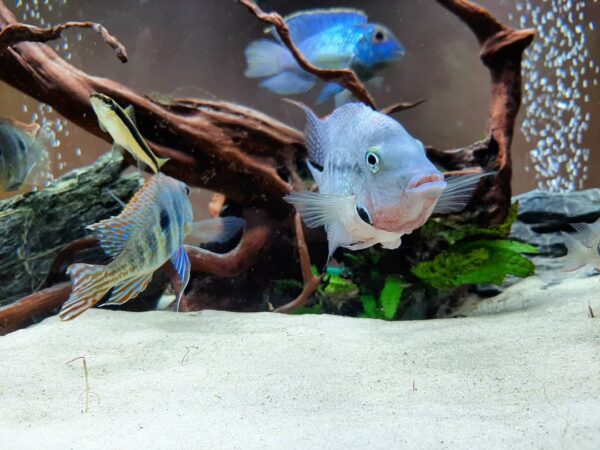
Table of Contents
Electric Blue Acara: A Quick Summary
Electric blue acaras are a colorful freshwater fish native to South America. They are semi-aggressive and should be kept with peaceful, similarly sized fish. They are omnivorous and require a varied diet of dry and wet foods.
Electric Blue Acara Overview
| Information Chart | Electric Blue Acara |
|---|---|
| Care Level: | Easy/Beginner |
| Temperament: | Peaceful |
| Color: | Electric blue |
| Lifespan: | 10 years |
| Size: | 5 - 7 inches |
| Family | Cichlidae |
| Diet: | Omnivore |
| Minimum Tank Size: | 30 gallons |
| Temperature: | 73° - 86° Fahrenheit |
| Water Conditions: | 0 - 10 KH and 6.0 - 7.2 pH |
| Tank Mate Compatibility | Moderate |
What stands out about the basic facts about this fish is how long it lives, and despite not being all that big – it can live for up to 10 years! That is quite a long time for a fish, as it might even outlive a large dog!
Having an electric blue acara is a big responsibility, and you should always make sure you are willing to care for it throughout its life, as many pet stores are reluctant to accept fully grown fish back.
Electric Blue Acara Background
Andinoacara pulcher is a genuine show-stopper with its surreal glow, making the aquarium tank it sits in stand out. It is a cichlid that hardly adjusts well to changes in the environment, and it can live for a total of 10 years when kept in good condition.
These swimmers are not new in the aquarium world, and they have been used in aquarium tanks for many years now.
You cannot go wrong with an electric blue acara – they are big enough to draw attention to themselves but small enough to fit comfortably in an average 30-gallon freshwater tank.
Electric Blue Acara Appearance
The iridescent electric blue color is one of the most beautiful features of this electric blue freshwater aquarium fish. It has orange, brown, black, and gray stripes on its body. It has fins of the same color and a dorsal fin that swims seamlessly through the water.
Its body shape is somewhat oval, and since it is a stocky fish, it looks plump and robust.
The spiny rays on the backs of their fins work as a protection against other aggressive fish, and the dorsal fin is often (but not always) pointed. The electric blue acara is similar to other cichlids, such as the green terror cichlid, but is at the same time very unique in its color.
You are unlikely to find any other breed that is as breathtakingly beautiful and at the same time so easy to care for, which is why the andinoacara pulcher is the pride and joy of several aquarium hobbyists and aquarium owners.
Electric Blue Acara Care & Tank Set-Up
Electric Blue Acaras require specific care and tank setup for optimal health. Provide a spacious tank with ample hiding spots and maintain stable water parameters. Consider a pH of 6.5-7.5 and a temperature range of 75-82°F. Compatible tankmates include peaceful species. Regular water changes and a balanced diet contribute to their well-being.
Tank Conditions (Size, Gallons)
It would benefit if you used a soft sand substrate to cover the bottom of the aquarium where the blue andinoacara pulcher lives since this allows your electric blue acara fish to dig without risking injury. Once that is done, it is time for plants!
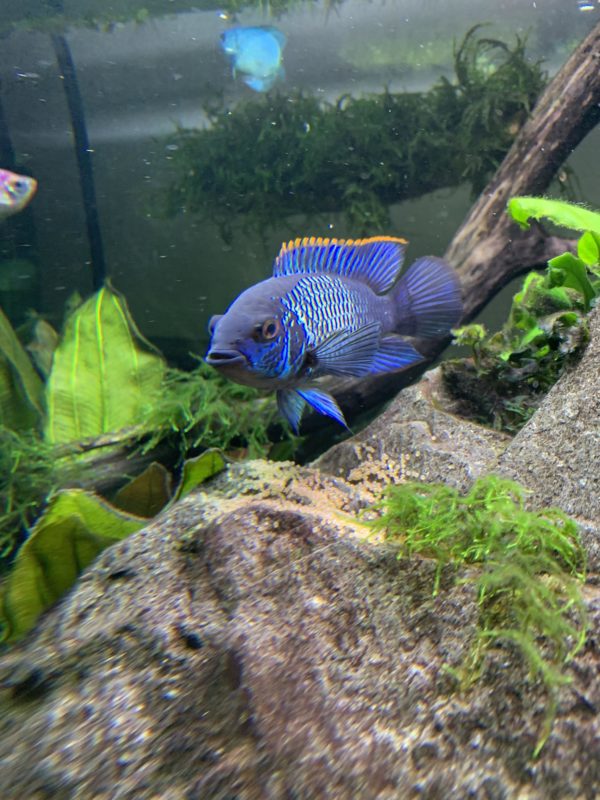
The blue andinoacara pulcher requires dense vegetation and plants it can hide among, and it is a good idea to go with either potted plants or plants that float on the surface and try to give the tank that cozy feel that a cichlid typically enjoys.
Keep in mind that while you should plant them close together to prevent a dense feeling, there should also be open space where the blue andinoacara pulcher cichlid can swim freely, as this is a cichlid that enjoys being active.
The electric blue acara can live for 10 years when kept in a property-conditioned tank.
Water Parameters for Electric Blue Acara
If you want your fish to thrive, you must have good water quality and follow the suggested water parameter requirements. Failure to do so will result in catastrophic health consequences.
On the other hand, electric blue acara is a resilient species of fish.
Water Temprature
For EBAs, the water temperature in the tank should be around 72 to 82 degrees Fahrenheit. If at all feasible, keep the temperature at 76°F.
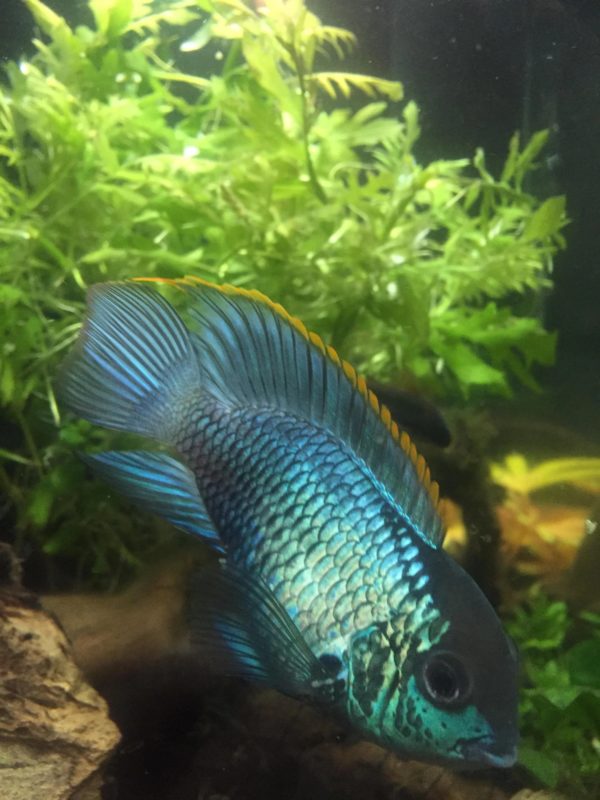
ph level
pH levels: These fish can tolerate a pH range of 6 to 7.5, but a pH of 7 to 7.5 is ideal.
Water Hardness
Hardness of water: 6-20 dH
Maintenance And Care
Caring for blue andinoacara pulcher cichlids isn’t very hard, and the electric blue acara is one of the easiest fish to keep and requires very little care. This freshwater fish is resistant and adapts easily to new and changing conditions in the tank, but you need to make sure that there is enough open space for the electric blue acara to swim.
These cichlids love to swim and explore, and it won’t be happy unless it can do so freely. If you have more than one electric blue acara, you need more space and more water, so plan when you set up your tank.
One thing that is important for a cichlid like the electric blue acara is the water quality, and with that in mind, have a proper filter installed and clean the tank accordingly. It is true for most fish, but the electric blue andinoacara pulcher is a cichlid that does not enjoy swimming in dirty waters. The electric blue andinoacara pulcher does a great job taking care of itself with some basic cichlid care needs provided.
Electric Blue Acaras Tank landscape
What Are The Best Plants For Electric Blue Acaras?
The natural habitat of the electric blue acara has a diverse range of plant species. Plants that can gain traction in the aquarium substrate, as well as floating plants, are best.
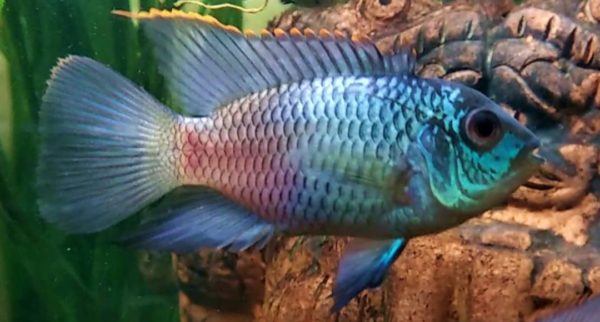
Because these fish are accustomed to viewing vegetation both in the water and on the land, you can experiment with various plant species and varieties.
- Java Moss
- Hornwort
- Vals
- Amazon Sword
- Java Fern
- Anubias Nana
- Floating vegetation
Electric blue acaras don’t consume plants very often. Therefore, you shouldn’t be concerned about putting dangerous plants in the tank.
It’s crucial to remember that other fish in your tank might consume them, so pick suitable plants for everyone.
What Should You Add To The Tank?
• Electric blue acara is low-maintenance. We recommend taking the time to make sure their environment is adequate. It will add to their happiness and serve as a virtue of comfort and enrichment. To do so, try to replicate their natural surroundings as much as possible with lots of hiding spots for them to feel comfortable. It offers them a feeling of safety and helps them relax a little (which is great for reducing stress).
• They will spend some time delving into the substrate and studying it. Ensure the substrate is not hard, or the fishes will cut or scrape themselves.
• You can add any floating plant, for example, hornwort, which will comfort them a lot. Plants and vegetation are frequently floating on the surface of the bodies of water that electric blue acara inhabit.
Feeding Electric Blue Acara
Cichlids like the electric blue acara are omnivores, but they favor a meat-based diet high in protein. Feed a base of quality fish flakes and the occasional treat of bloodworms and other live food.
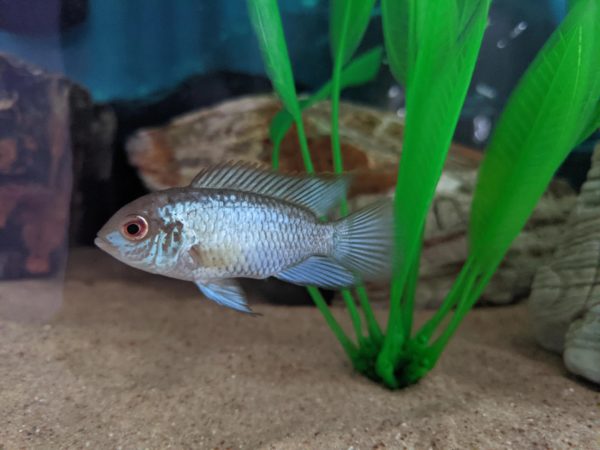
You can also treat your fish with vegetables like broccoli on special occasions. Variations in their diet will help keep your electric blue acara motivated and prevent it from getting bored.
You may want to feed your electric blue acara 3-4 times per day, as this fish tends to gulp down their food and eat very fast.
It is better to split up the meals as this could also help prevent rivalry in the tank when all fish are trying to get a hold of food. Below is a list of good things to feed your electric blue acara, other than flakes (but it should not make up their whole diet):
- Brine shrimp
- Blanched cabbage
- Boiled peas
- Tubifex
- Earthworm
- Insect larvae
- Cyclops
- Boiled spinach
No cichlid benefits from being overfed, so monitor how much food you feed every day to prevent your cichlid fish from overeating, as this could lead to a wide range of health problems. You should stick to feeding a quality brand of fish food for your cichlid fish to stay healthy and live a long life.
Electric Blue Acara Behavior and Temperament
Cichlids are somewhat aggressive when put in a tank with other fish, but the electric blue acara – despite being a cichlid. It rarely presents aggressive behaviors and will almost always get along well with other fish of various sizes. But they act territorial if there is not enough room for the number of (especially) male fish in the aquarium.
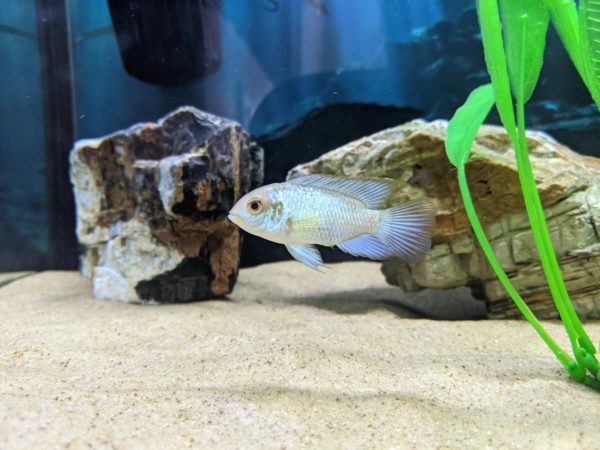
You can generally prevent this issue by getting a right-sized aquarium with enough fish and places to hide.
The electric blue acara is known for burrowing and digging in the material at the bottom of the aquarium, which can be quite entertaining to watch!
They are social fish that are not prone to hiding, but the digging is especially intense when the electric blue acara is getting ready to breed. Electric blue acara fish love to swim, and you will likely see your fish spending the day swimming around.
Electric Blue Acara Suitable Tank Mates
Electric Blue Acaras can coexist with various peaceful fish species, such as tetras, rasboras, and dwarf cichlids, in a well-maintained aquarium. However, aggressive or territorial fish should be avoided to prevent conflicts. Suitable tank mates should share similar water requirements and temperament to ensure a harmonious community tank for the Electric Blue Acara.
These fish are compatible with other fish as tank mates, and it is smart to place them with others of the same breed or for their tank mates to be fish of a similar size and with friendly personalities. Size matters, in this scenario, for the fish to live peacefully together.
You don’t want to match them with much larger fish as they could become prey, and aggressive fish will cause anxiety and disruption in the tank. Very small fish is also a bad idea as it could, unfortunately, be confused with live food.
The electric blue acara is not usually aggressive or territorial. Still, they might chase off other fish if they feel it is on their territory or during the breeding season. You can usually avoid this by making sure there are enough live plants, rocks, and caves for them to hide. Hence set up your freshwater tank in a conscious way.
Cichlid gets along with most fishes, but you have to make sure the size of the tank is not too small for them all to live in harmony. The care you put into choosing tank mates determines your fish’s comfortability. The andinoacara pulcher is easy to care for, but like any other fish – it has its preferences.
Best Tankmates For Electric Blue Acaras
1. Discus
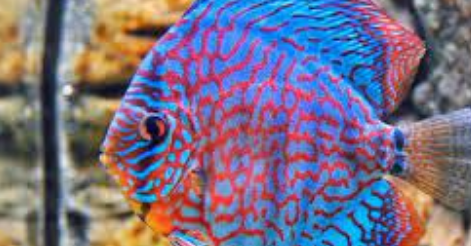
Discus is the most colorful fish. When coupled with the electric blue acara, they come in various colors and patterns. Combining the two species can result in a colorful and attractive community tank. This arrangement will create a vibrant highlight in the tank when set against a dark background and greenery plants.
Discus is a social fish that you should keep in schools, and they rarely bother the other fish in the tank.
2. Oscars
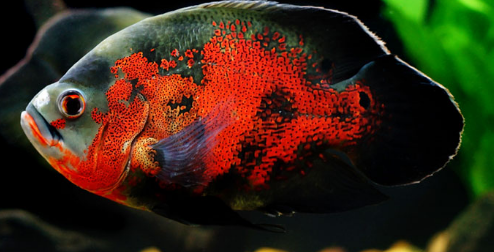
Although oscars are known for being violent, you can house them alongside adult electric blue acara. If you want to keep these two fish together, keep an eye on their behavior in the tank so you can see any fighting right away. Oscars get along well with electric blue acaras in general, and they can live peacefully together if the tank is large enough.
3. Silver Dollar
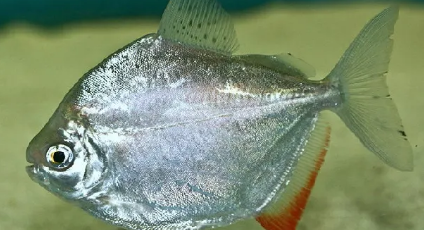
Silver dollars are exceedingly quiet. If you keep them in small-sized groups, they can become shy. Silver dollars have an iridescent shine across their silver bodies like the electric blue acara. They get along with a wide variety of fish and don’t cause any problems in community tanks.
4. Bristlenose Pleco
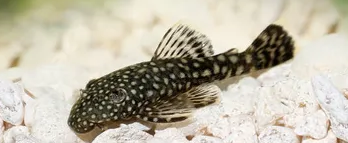
The bristlenose pleco is a smaller variant of the common pleco. Because bristlenose grows so little, you can house them in smaller aquariums. They are quiet and hang out towards the aquarium’s bottom. They are the ideal tank mates for a community of electric blue acara. They are simple to look after and normally go about their business. They spend most of their time sucking at the tank’s surfaces and removing superfluous algae.
5. Rainbowfish
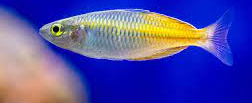
When housed with electric blue acara, rainbowfish are bright and appealing. They are calm and friendly tank companions who do not bother electric blue acaras. They eat the same meals and require the same level of attention. Rainbowfish should be kept in small groups to avoid hostile behaviors among themselves.
6. Cory Catfish

The cory catfish is a shoaling fish that cleans the bottom. They spend their time rummaging around the substrate seeking scraps of food. It is best to keep them in groups of six or more and, as an albino, come in a variety of hues. They are playful and like engaging with one another and their tankmates. In a communal tank, they rarely create problems and get along nicely with electric blue acara.
7. Giant Danios
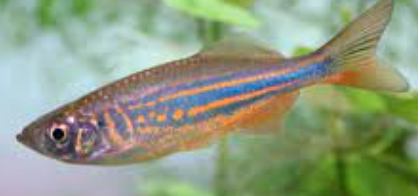
If you want the color of a small diano but can’t keep it with electric blue acara as EBAs will eat it, the huge danio is the next best thing. They’re bright shoaling fish that should be kept in at least eight schools. They are identical to the original danio and demand the same level of care. They are rambunctious and may prey on electric blue acara if bored.
8. Moga Cichlid
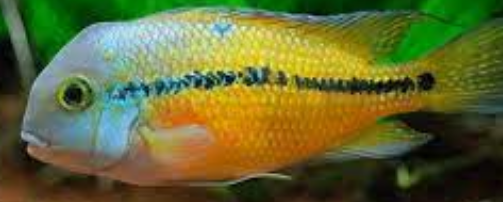
Another vibrant tank partner for electric blue acara is the moga cichlid. They are iridescent, too, and come in a variety of colors. Due to their peculiar tendencies can cause some havoc in a community tank; however, this is rarely a major issue, and if the tank is large enough, they will keep to themselves.
9. Gouramis
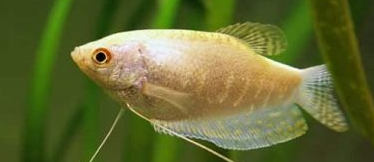
Gouramis have always been a popular choice for community tanks. They are colorful and gentle, allowing them to coexist with various fish species, including the electric blue acara. They don’t fight or bother their tank mates, and they can be bashful enough to hide among the plants.
10. Angelfish
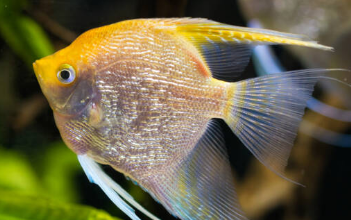
Angelfish are schooling fishes that get along well with electric blue acara. Angelfish have a distinct appearance when compared to other fishes. Therefore, they bring variety to a communal aquarium. They prefer a tank with many plants, which the electric blue acara also enjoys. Temperature and water quality are far more important to angels than the electric blue acara.
Which Fishes Are Incompatible With Electric Blue Acaras?
Remember, the electric blue acara is its own greatest tank companion! These fishes can be kept in groups and coexist nicely with their species.
Of course, there are some species that one should not keep with electric blue acaras. Keep an eye out for aggressive fish like the following:
- Angelfish
- Dwarf Cichlids
- Cichlasoma
Size and temperament are usually the deciding factors. When choosing tank mates for your acaras, use your best judgment.
What Makes Electric Blue Acara A Good Tank Mate?
The bristlenose pleco is one of the greatest tank mates for electric blue acara. They rarely interact; therefore, you can keep them together in a smaller tank with other free-swimming fish. They are calm and go about their business at the bottom of the aquarium.
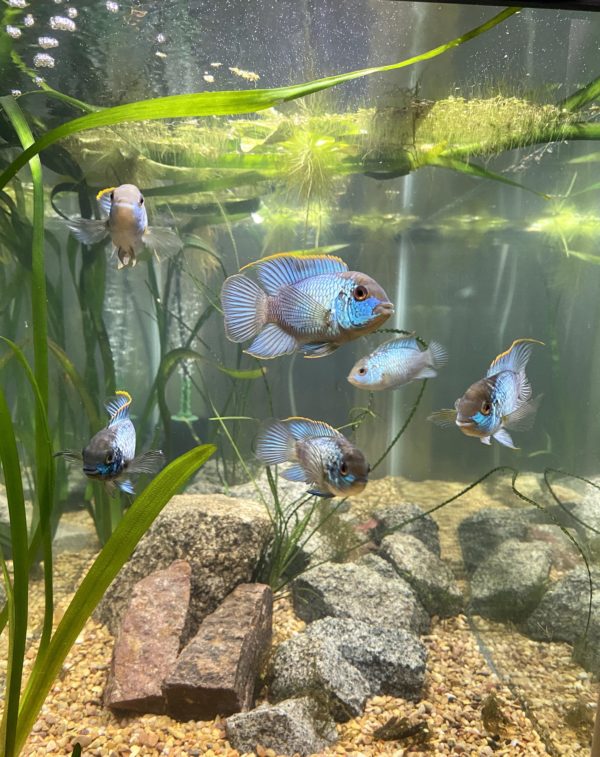
Electric blue acaras are rarely aware that a bristlenose pleco is present in the tank, making it the best tank mate for all sizes of electric blue acaras.
What Aquarium Habitats Does Electric Blue Acara Prefer?
The upper or middle level of the aquarium houses most electric blue acaras. They spend time with one another and create lifelong bonds with their partners. Unless there is food collected in the substrate, it will rarely travel to the bottom of the tank. They thrive in fast-moving currents, swimming for most of the day and resting among plants and other decorations at night.
Breeding Electric Blue Acara
When the electric blue acara is between 8 and 10 months, it is considered mature enough to breed, and they will usually find their ideal pair in the tank on their own.
With this in mind, it is a good idea to have a group of electric blue acara fish that gives them the freedom of choice, and when you know which pair to breed – you can move them over to a 20-gallon breeding tank.
A cichlid like this has a very simple breeding process, and breeding is quick and simple, but they do need a proper breeding environment.
There should be fewer plants in the breeding tank, and you may want to opt for plants with larger leaves and a substrate with larger grains. The temperature in a breeding tank should ideally be about 77 degrees Fahrenheit; once the spawning is complete, you will want to remove the adult fish to prevent them from eating their fry.
There may be a few things to think about when trying to breed the Electric Blue Acara, but it does not change that the andinoacara pulcher is perhaps the easiest cichlid to breed.
Electric Blue Acara Common Diseases and their Treatment
Freshwater diseases affect electric blue acaras due to inadequate food and bad water conditions. That’s why ensure the aquarium fishes have a healthy habitat and constantly lookout for any signs of illness in the aquarium fish.
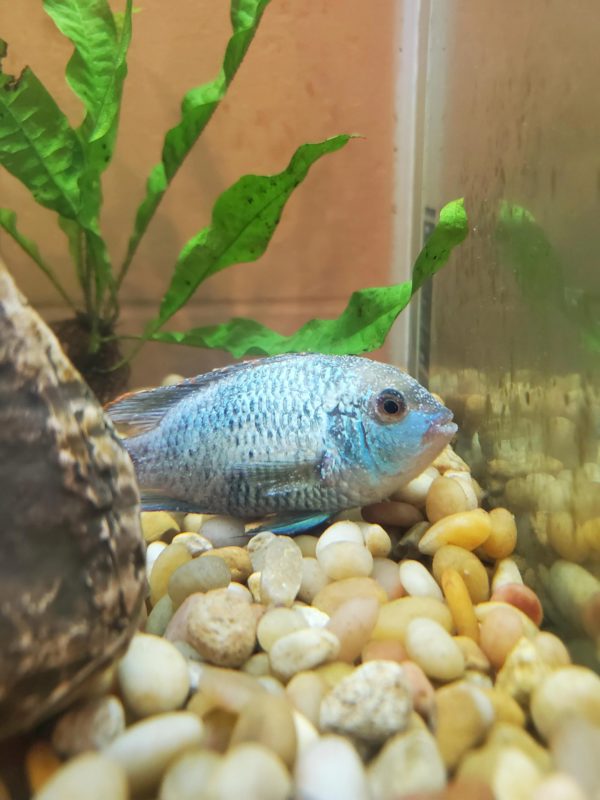
Malawi bloat is a sickness that affects cichlids in Malawi. Cichlid bloat is another term for this condition.
Poor food, poor water quality, and the bacteria clostridium difficile have all been key contributors.
Malawi bloat causes a bloated abdomen and a diminished appetite or complete loss of appetite in fish. Another symptom is difficulty breathing, which causes the fish to start breathing rapidly.
Use antibiotics such as metronidazole, octozin, and others as the best treatment.
The electric blue acara can also be afflicted with skin flukes. The fish’s skin will get inflamed as a result of this condition. The fish will start scratching itself against any hard surface in the aquarium to relieve the irritation. It can cause the fish to acquire a potentially lethal secondary infection in addition to skin damage.
This condition can cause the fish to lose color, become unhappy, and be lethargic, in addition to the skin damage.
Praziquantelis is the most widely utilized therapy.
Another disease that can harm electric blue acaras is freshwater ich. Infected fish will develop white spots on their bodies, which they will try to scrape off with their claws on any hard surfaces in the tank. Other signs and symptoms include a loss of appetite and respiratory difficulties. Some fish will become anxious and begin to hide.
Formalin, sodium chloride, and malachite green are effective treatments for ich. In addition, most treatments entail raising the temperature of the water to aid in the disease’s eradication.
Stress
Stress is something that fish, like people, must cope with regularly.
Looking into your aquarium, you would assume what a tranquil existence it must be. After all, fish spend their days swimming around in a lovely tank while their owner feeds and cares for them. Contrary to popular belief, fish can grow irritated in the same way as humans do.
Stress can accumulate in fish resulting in health problems just like in humans. That’s why it is crucial to acknowledge whenever your fish gets under stress or is anxious.
- Symptoms: Pay attention to any of your fish’s stress signals.
- Breathing heavily at the Surface: A fish gasping at the surface is a sign of stress induced by poor water conditions, the most common of which is a lack of oxygen.
- Appetite: An anxious fish may refuse to eat.
- Disease: Stress can lead to ich or white patches on a fish’s body and other diseases. Contact your veterinarian for treatment options if you observe this or any other obvious ailments or sores on your fish.
- Disturbing Swimming Movements: They frequently adopt disconcerting swimming patterns when fish are disturbed. If your fish is swimming erratically without going somewhere, slamming at the bottom of his tank, rubbing himself against gravel or pebbles, or locking its fins at his side, he may be anxious.
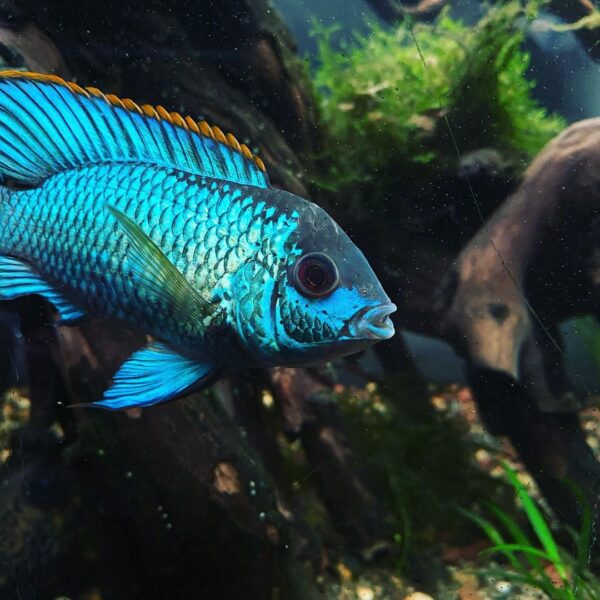
Contact your veterinarian about clinical needs and figure out what’s causing the stress and how to relieve it.
Causes
- A variety of events might create stress in fish. Almost any event that causes changes in habitat or a disturbance in routine and behavior can produce stress. The following are some examples:
- Inadequate water conditions: If your fish’s tank’s water is not kept clean, it might cause stress. If your fish is gasping near the surface, you should conduct a quick water test to determine if anything is wrong. High ammonia or nitrate levels, low oxygen levels, inappropriate temperature, or a high or low pH can produce stress. In a saltwater tank, incorrect salt levels can have a similar effect.
- Issues with other fish: Like humans, not all fish live well with too many fishes, which might make them feel trapped. Ensure your aquarium isn’t overcrowded, which can lead to problems such as fish fighting and poor water quality. To avoid predators, fish require a variety of hiding spots. When feeding your fish, try to divide the food evenly so that the fish are not competing for food.
- Other aspects to consider: In addition to the factors already mentioned, a few others contribute to stress. One of them is the existence of any additional chemicals or drugs in the fish’s tank. Before treating a sick fish, ensure it’s properly isolated.
Furthermore, a bad diet might lead to stress. Ensure you know what kind of diet your fish needs and attempt to keep to it. Lastly, external stressors such as hammering or loud noises can stress fish. Teach your children to maintain the fish’s habitat if you have them.
pH Shock In Electric Blue Acaras
If you have a fish suffering from pH shock, you’ll have to rely on the fish’s hardiness and a little luck. However, there are several things you can do that will undoubtedly help:
To begin, you must restore the pH range of your water to that of the fish. Even though this is another pH alteration of the same magnitude, your fish is more likely to settle down when you return water to its original condition of comfort. One can accomplish this by relocating the fish to a new tank or doing a significant water change.
If possible, you must also eliminate the source of the issue. If aquarium wood, coral sand, or something else caused the pH change, remove it to avoid the problem from recurring.
Add some oxygen to the mix. You can install an air pump or create a surface disturbance. Shock can make it harder for a fish to breathe; increasing the amount of oxygen in the water will greatly assist them. Because gas exchange occurs at the water’s surface, disrupting it with a stream of bubbles to increase the oxygen content of the water.
Quickly catch it! You’ll need to catch your fish quickly to save it from pH shock or any shock. Fish can quickly succumb to shock. Thus, the faster you can improve the fish’s position, the better.
Things To Remember for pH shock
Prevention is always preferable and involves far lesser risk than cure. pH shock is rather easy to avoid; routine maintenance (water changes) is essential, like double-checking the water quality before putting them in your tank. If you do a little research, you’ll determine that wood and coral sand are two frequent aquarium components that impact pH.
How To Safely Adjust pH?
It is possible to safely adjust the pH of your aquarium water if you find yourself in a scenario where you need to re-adjust the pH of your aquarium, such as realizing you’re keeping your fish in less-than-ideal conditions.
While some fish will withstand a sudden change in pH, others will not. Thus, it is best to alter pH over several days gradually. For most fish, a pace of 0.5 pH changes per 48–72 hours should be enough; however, the slower the shift, the safer it is.
Natural objects like driftwood, peat moss, and coral sand can help you balance your pH, but it’s tough to say how much they’ll help. Slowly add them in little increments, measuring the change as you go. There are also store-bought items available to modify the pH of your water, but use them with caution and always follow the instructions since the results might be drastic.
Do note that you should only interfere and alter the pH of the water if your fish is in distress. If the pH is slightly out of range yet the fish seems fine, you should consider that pH only.
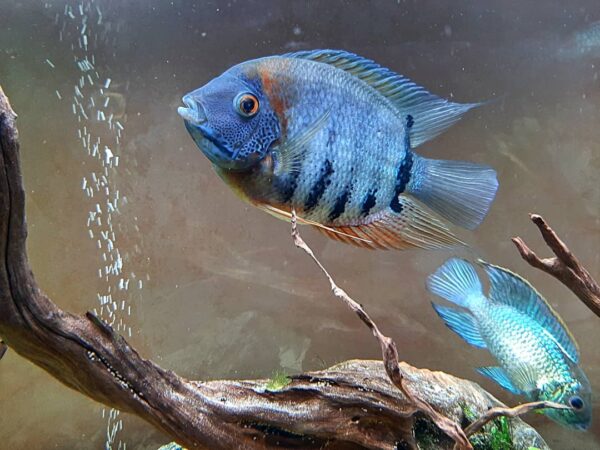
Two Advantages of Having Electric Blue Acara Tank Mates in Your Aquarium
- Tankmates give color to the aquarium and can help you create a vibrant community tank. Electric blue acaras appreciate having tank mates, which can help them feel less stressed, remaining healthy and happy.
- Interacting with their tank mates can provide enrichment and stimulation to electric blue acaras.
Dos And Don’ts For Selecting Electric Blue Acaras
Do’s
- Set up a big tank for them. Suppose the required tank size for electric blue acaras is 40 gallons. You must also include the minimum tank size for that tank mate if you want to keep them together. You will require a tank with a nominal capacity of 60 gallons if you want to keep a pair of electric blue acara and a bristlenose pleco.
- If the fish can fit inside the jaws of an electric blue acara, it will consume it.
- Make a highly vegetated aquarium so that each fish has a place to hide if they feel threatened.
- Make sure each tank buddy has the right shoal size to simulate group hostility.
Don’ts
- Electric blue acaras should not be kept with African blood-parrot cichlids because these fish are known to chase acaras out of the aquarium.
- Do not keep violent fish with electric blue acaras since they may be attacked and injured.
- Do not leave the tank open; instead, cover it with a robust aquarium lid to keep the blue acaras from leaping out.
FAQs
How Big Do Electric Blue Acaras Get?
The size of an adult electric blue acara can vary, but they usually grow to be somewhere between five and seven inches.
What do you feed Electric Blue Acara?
Electric blue acara fish are omnivores and can eat both live animals, plants, and vegetables, but they are closer to being carnivores than anything else. The best thing is to feed a balanced flake diet, with other live food and vegetables.
Are Electric Blue Cichlids Aggressive?
It is rare for the electric blue acara to be aggressive, despite being a cichlid, and they never tend to display these types of
How Fast Does Electric Blue Acaras Grow?
Fish like the electric blue acara grow continuously throughout the first few months of its life. You can consider them fully grown by the time it is 8-10 months old.
Conclusion
Electric blue acara is a great fish for beginners, as it requires a tank of average size, quite average care, and nothing out of the ordinary. Being able to care for a stunning fish like the electric blue acara is a great way to gain confidence as a hobby aquarist, so make sure you have a tank that is not too small, a stable water temperature, an appropriate tank mate, and nutritious fish food.
You can soon witness it swimming happily in the tank.
No related posts.
